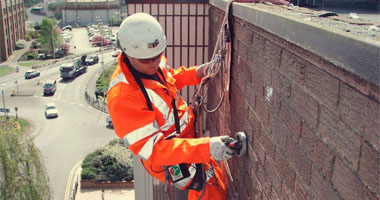
Building Envelop Inspection
Our experts investigate any faulty aspects that causes leakage or any damage to your buildings for the structural integrity. This includes roofs, floor, ceiling, windows, walls, doorways, etc.
Rope access is a form of positioning that allows trained workers to access difficult to reach areas without the use of traditional methods, such as aerial lifts and scaffolding. The concept of rope access was implemented by the U.S. Navy as a way to gain access to perform work at the inaccessible areas on large ships.
The majority of work was done from a bosun’s chair, which was a platform generally made from heavy duty canvas, mechanically attached to a rope; a worker could sit on the platform and ascend or descend in a controlled manner. During the 1980s, the use of the traditional bosun’s chair was integrated with climbing, caving techniques, and equipment to better assist workers to gain access to the hard-to-reach areas. While the fundamentals of ascending and descending down a rope remained the same, the new and more sophisticated equipment now allowed workers to safely position themselves in ways a conventional bosun’s chair could not.
Rope access in accordance with either SPRAT or IRATA practices is being used more commonly as a way to safely gain access to perform inspections and general emergency repairs to the exteriors of buildings and structures. Rope access has proven to be a more efficient and cost-effective means of conducting non-destructive investigations of building exteriors than scaffolding and bridging systems. However, while this form of access might be a more cost-efficient mobilisation method for inspection purposes, it does not provide adequate protection when performing exterior façade-work related tasks. Additionally, the limited tools and materials at the disposal of workmen who are not necessarily in the most ergonomic position, can hinder production.
